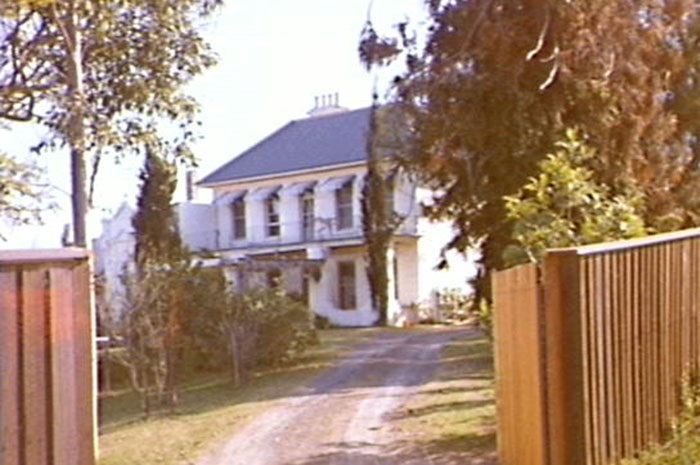History of Eschol Park
The suburb of Eschol Park is spelt wrongly. By all rights, it should be "Eshcol Park", because that was the original title given to its namesake property in 1858 by William Fowler.
He was a devout Christian and because it was a vineyard he was establishing on the hillside property, he named it after the "Promised Land of Eshcol" in the Bible.
But right from the outset there were problems with the awkward spelling. Even in the earliest church registers and land title documents, "Eshcol" was often mistakenly spelt as "Eschol".
In 1975, when plans for a suburb at the site were under way, the Geographical Names Board inadvertently approved the use of the wrong spelling. And 20 years later, the name is too well entrenched to ever be corrected. Even Fowler's old home is known as Eschol Park House(PDF, 197KB), and is a popular local restaurant.

"Eschol Park" in 1979
The earliest sections of the old homestead was built about 1816, on a property that was to become well-known as Eagle Vale. Hence the name of the neighbouring suburb.
But when William Fowler took over the large holding in the 1850s, he gave it his preferred Biblical title. An avenue of fine old trees in Eschol Park Drive, off Raby Road, guards what was once the entrance to the historic mansion.
As well as being a warden and trustee of St Peters Anglican Church, Fowler was a Campbelltown storekeeper and postmaster. His premises were at 292-294 Queen Street, one of the four Georgian homes opposite Campbelltown Shopping Mall, and some extensions he made are still clearly visible on close examination of the stonework.
Fowler quickly established an extensive vineyard and two-storey winery on his property, and within a decade or so, was producing 2000 to 3000 gallons of award-winning wines.
In 1876, he sold all his land to Samuel Spencer Milgate, who owned a local produce store off Queen Street.
John Gorus, a Dutch photographer, bought the property two years later and continued the viticulture tradition.
While Gorus was the owner, Eschol Park was auctioned by Hardie and Gorman. The pamphlet described a brick and stone residence, wine cellars, an ornamental lake, extensive flower gardens, and an orchard planted with oranges, bananas, and almost "every description of stone fruit".
Farm buildings included a stable, cow house, buggy house, carpenter's workshop and a slaughter house. One feature described in the auction pamphlet was a large manure tank "into which the sweepings of the sheep sheds, stables, and fowl houses are placed ; there they remain until winter, when each vine and tree that appears to require assistance receives its share."
But vineyards across the region were badly hit in the 1890s when the phylloxera disease struck, and Eschol Park was devastated.
The area remained rural hills, dominated by dairy cattle, until the mid-1970s, when it was earmarked for future housing developments.
By April 1978, Landcom was pressing Campbelltown Council to decide on some street names for its Highfield Estate, the first part of the proposed suburb. Its brick gateway can still be seen off Raby Road.
Given the famous wines that once covered the slopes, it was decided to name all of Eschol Park's streets after varieties of grape grown in Australia, as well as wine types, methods and terms.
To this end, grape varieties are today recalled by Cabernet Avenue, Chardonnay Avenue, Pinot Street, Chasselas Avenue, Muscat Place, Frontignan Place, Albillo Place, Sauvignon Close and Tokay Place.
Also Riesling Place, Shiraz Place, Marsanne Place, Malbec Place, Doradillo Place, Grenache Place, Trebbiano Place, Semillon Crescent, Palomino Close, Sercial Place, Traminer Place and Mataro Place.
Wine types, methods and terms included are Burgundy, Chablis, Claret, Dalwood, Hermitage, Michinbury, Moselle, Solero, Sauternes, Spumante and Tanunda. Brand names also get a look-in with Hardy Street and Wynn Street.
Eschol Park Primary School was opened in 1985, and the nearby Eschol Park Sports Complex was created in the early 1980s.
This complex, consisting of sporting fields which double as water detention basins in times of flood, follows a branch of the old Eagle Creek. This was converted into a series of cascading detention basins in the 1970s, and a public park now stands on what was once the headwaters - Eagle Creek Reserve.
A minor tributary creek running into it had once been known as "Vale Brook". Hence the name Vale Brook Reserve. The early vigneron of Eschol Park himself is remembered by William Fowler Reserve.
"Campbelltown's Streets and Suburbs - How and why they got their names" written by Jeff McGill, Verlie Fowler and Keith Richardson, 1995, published by Campbelltown and Airds Historical Society.
Reproduced with permission of the authors.